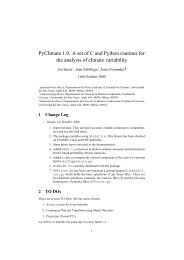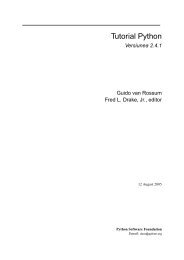PyClimate 1.1. A set of C and Python routines for the ... - Starship
PyClimate 1.1. A set of C and Python routines for the ... - Starship
PyClimate 1.1. A set of C and Python routines for the ... - Starship
You also want an ePaper? Increase the reach of your titles
YUMPU automatically turns print PDFs into web optimized ePapers that Google loves.
an array with as many heterogeneous correlation maps )as columns (expansion coefficients) are in ycoefs. The ordering <strong>of</strong> <strong>the</strong> maps is as describedin previous routine.Function: def SCF(sigmas)This function returns <strong>the</strong> squared covariance fraction associated to each singular value,+*¤#,% or(') "$#&% (!scf#.- /0 1243 /0 1from<strong>the</strong> array5 returned by svd().Function: def CSCF(sigmas)This function returns <strong>the</strong> cumulative squared covariance fraction associated to a <strong>set</strong> <strong>of</strong>singular cscf#6- values,21, from <strong>the</strong> 2 3 /0array5 returned by svd().Function: def makemctest(Um,Vm,ldata,rdata,itimes,ielems)This function per<strong>for</strong>ms a Monte Carlo test on <strong>the</strong> stability <strong>of</strong> <strong>the</strong> left singular vectorsUm <strong>and</strong> <strong>the</strong> right singular vectors Vm obtained from svd() or truncated to <strong>the</strong>; /0 798: #leading ones (Um.shape[-1]==Vm.shape[-1]). It computes itimes simultaneoussubsamples (ielems long each) <strong>of</strong> each datafield ldata, rdata, <strong>and</strong> evaluates <strong>the</strong>congruence coefficient <strong>of</strong> <strong>the</strong> master singular vectors to those derived from <strong>the</strong> subsamples.It returns a tuple <strong>of</strong> Numerical <strong>Python</strong> arrays (ucoefs,vcoefs) whichhold <strong>the</strong> congruence coefficient <strong>for</strong> each sample <strong>and</strong> each U/V master singular vector(ucoefs.shape=(itimes,Um.shape[-1])). ielems must be smaller thanlen(ldata).9 CCA (Canonical Correlation Analysis)Canonical correlation analysis can be per<strong>for</strong>med by bpcca.py. This technique gets<strong>the</strong> pattern decomposition <strong>of</strong> two fields such that <strong>the</strong> correlation between <strong>the</strong> temporalcoefficients <strong>of</strong> paired patterns is maximum. The Barnett <strong>and</strong> Preisendorfer [1] approachhas been implemented. In this approach an EOF prefiltering is per<strong>for</strong>med <strong>and</strong> <strong>the</strong> CCAis carried out in EOF–coordinates. The user never deals with <strong>the</strong>se coordinates but cancustomize some features <strong>of</strong> <strong>the</strong> EOF decomposition.The results are scaled <strong>for</strong> <strong>the</strong> canonical expansion coefficients to have unit variance.If <strong>the</strong> columns <strong>of</strong>< <strong>and</strong>= are <strong>the</strong> canonical expansion coefficients <strong>and</strong>> <strong>and</strong>? are<strong>the</strong> canonical patterns, <strong>the</strong> fields@ <strong>and</strong>A can be partially (due to <strong>the</strong> EOF prefiltering)recovered as: BBThe internal calculus are carried out by means <strong>of</strong> singuar value decomposition <strong>of</strong> <strong>the</strong>principal component cross covariance matrix.E AF-F=G? @C-4.EClass: bpccaFunction: def init (sfield, zfield, retainede<strong>of</strong>s=None)Given two two–dimensional data<strong>set</strong>s this constructor per<strong>for</strong>ms <strong>the</strong> CCA decomposition<strong>of</strong> <strong>the</strong> fields. sfield <strong>and</strong> zfield are <strong>the</strong> left <strong>and</strong> right fields respectively. The user canspecify <strong>the</strong> number <strong>of</strong> EOFs to be retained in each field as a tuple retainede<strong>of</strong>s. Ifno retainede<strong>of</strong>s is specified 70% rule is used: EOFs are retained until a 70% <strong>of</strong> <strong>the</strong>variance is explained.Function: def leftpatterns()This method returns an array which columns are <strong>the</strong> left (those associated to <strong>the</strong> sfield)canonical patterns.12









